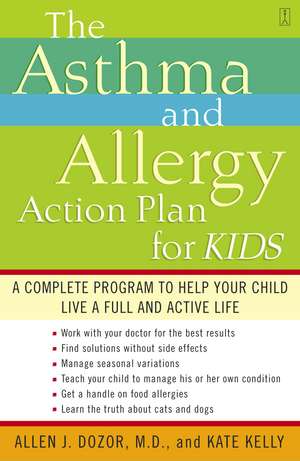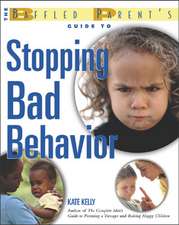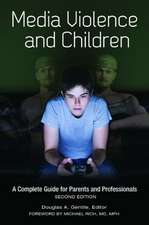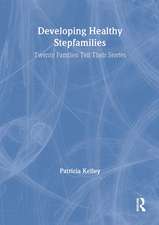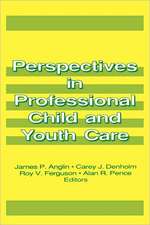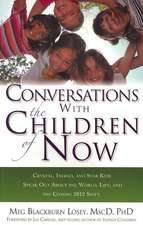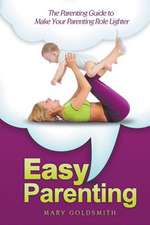The Asthma and Allergy Action Plan for Kids: A Complete Program to Help Your Child Live a Full and Active Life
Autor Dr. Allen Dozor, Kate Kellyen Limba Engleză Paperback – 21 mar 2005
Preț: 156.27 lei
Nou
Puncte Express: 234
Preț estimativ în valută:
29.91€ • 32.47$ • 25.12£
29.91€ • 32.47$ • 25.12£
Carte disponibilă
Livrare economică 01-15 aprilie
Preluare comenzi: 021 569.72.76
Specificații
ISBN-13: 9780743235778
ISBN-10: 0743235770
Pagini: 416
Ilustrații: 4 b&w illus
Dimensiuni: 140 x 216 x 25 mm
Greutate: 0.44 kg
Ediția:04000
Editura: Touchstone Publishing
Colecția Touchstone
Locul publicării:United States
ISBN-10: 0743235770
Pagini: 416
Ilustrații: 4 b&w illus
Dimensiuni: 140 x 216 x 25 mm
Greutate: 0.44 kg
Ediția:04000
Editura: Touchstone Publishing
Colecția Touchstone
Locul publicării:United States
Notă biografică
Allen J. Dozor, MD, is chief of pediatric pulmonology at the Maria Fareri Children's Hospital at Westchester Medical Center and professor of pediatrics at New York Medical College.
Kate Kelly (1950-2012) was the coauthor of two bestselling books, You Mean I’m Not Lazy, Stupid, or Crazy?! and The ADDed Dimension. An advanced practice mental health nurse with over thirty years’ experience as a family, group, and individual therapist, she was a legendary pioneer in the world of Adult ADHD and founded the ADDed Dimension Coaching Group.
Kate Kelly (1950-2012) was the coauthor of two bestselling books, You Mean I’m Not Lazy, Stupid, or Crazy?! and The ADDed Dimension. An advanced practice mental health nurse with over thirty years’ experience as a family, group, and individual therapist, she was a legendary pioneer in the world of Adult ADHD and founded the ADDed Dimension Coaching Group.
Extras
Introduction: Why This Book Is So Important to Me
Soon after I began working in medical research as part of a summer science program in high school, I knew that I loved academic medicine. Clinical research seemed a great way of combining my desire to do something "important" with the joy of learning. I devoted most summers in high school and college to cardiac and cardiovascular research, and I seemed destined for a career as an academic cardiologist. But in my pediatric residency in New York City, I learned that the number one reason children were hospitalized was respiratory disease. For three years I worked more than a hundred hours a week caring for children with difficulty breathing. I was struck by how little we really understood about common childhood illnesses such as allergies and asthma, croup, bronchitis, pneumonia, and cystic fibrosis; and how often our medications proved inadequate. I remember doing everything I could for a child and then sitting with anxious parents, all of us praying their child would get better.
It's hard to believe now, but back then there were no specialists for these most common illnesses in pediatrics -- there were no pediatric pulmonologists. When I learned that a few of the major children's hospitals in the country had small training programs, including Harvard's Children's Hospital in Boston, a lightbulb went on for me. Here was an opportunity to do something new and special and very important.
I was fortunate to have excellent pediatricians, who were really good at taking care of children with breathing problems, as role models. With their guidance, I cared for hundreds of children with asthma and watched many patients of all ages die of respiratory failure -- from two-pound babies in the neonatal ICU to teenagers and young adults with cystic fibrosis. As a resident I often stayed up all night at the bedside of a child gasping for air. I remember like it was yesterday an eight-year-old with severe croup, a disease that normally affects infants and toddlers. With croup, anxiety and fear significantly worsen respiratory distress, so I spent the night holding this boy's hand and reassuring him to keep him calm. By the time the sun came up the next morning, the medicines had taken effect. His breathing relaxed at last. I felt exhilarated; we had made it through together.
Children are so wonderful, so innocent and fresh, so trusting and appreciative. No matter how tired I was after one of those thirty-six-hour shifts, I would saunter home feeling so lucky that these children and their parents allowed me to share these special moments with them. I continue to pursue solutions for these children; and I have made my life's work caring for youngsters who suffer from all types of breathing difficulties. While much of this information is applicable to adults, my area of expertise is children. If your child with allergies or asthma is older than twenty-one, this is not the book for you.
I have written this book to empower parents not to settle for less than optimal control of their child's allergies or asthma. Parents have the right to demand more from their physicians and from the medications they prescribe. I want to convey this message to as many parents as possible so our children grow up living happy, active lives.
Allen J. Dozor, M.D.
August 2003
Soon after I began working in medical research as part of a summer science program in high school, I knew that I loved academic medicine. Clinical research seemed a great way of combining my desire to do something "important" with the joy of learning. I devoted most summers in high school and college to cardiac and cardiovascular research, and I seemed destined for a career as an academic cardiologist. But in my pediatric residency in New York City, I learned that the number one reason children were hospitalized was respiratory disease. For three years I worked more than a hundred hours a week caring for children with difficulty breathing. I was struck by how little we really understood about common childhood illnesses such as allergies and asthma, croup, bronchitis, pneumonia, and cystic fibrosis; and how often our medications proved inadequate. I remember doing everything I could for a child and then sitting with anxious parents, all of us praying their child would get better.
It's hard to believe now, but back then there were no specialists for these most common illnesses in pediatrics -- there were no pediatric pulmonologists. When I learned that a few of the major children's hospitals in the country had small training programs, including Harvard's Children's Hospital in Boston, a lightbulb went on for me. Here was an opportunity to do something new and special and very important.
I was fortunate to have excellent pediatricians, who were really good at taking care of children with breathing problems, as role models. With their guidance, I cared for hundreds of children with asthma and watched many patients of all ages die of respiratory failure -- from two-pound babies in the neonatal ICU to teenagers and young adults with cystic fibrosis. As a resident I often stayed up all night at the bedside of a child gasping for air. I remember like it was yesterday an eight-year-old with severe croup, a disease that normally affects infants and toddlers. With croup, anxiety and fear significantly worsen respiratory distress, so I spent the night holding this boy's hand and reassuring him to keep him calm. By the time the sun came up the next morning, the medicines had taken effect. His breathing relaxed at last. I felt exhilarated; we had made it through together.
Children are so wonderful, so innocent and fresh, so trusting and appreciative. No matter how tired I was after one of those thirty-six-hour shifts, I would saunter home feeling so lucky that these children and their parents allowed me to share these special moments with them. I continue to pursue solutions for these children; and I have made my life's work caring for youngsters who suffer from all types of breathing difficulties. While much of this information is applicable to adults, my area of expertise is children. If your child with allergies or asthma is older than twenty-one, this is not the book for you.
I have written this book to empower parents not to settle for less than optimal control of their child's allergies or asthma. Parents have the right to demand more from their physicians and from the medications they prescribe. I want to convey this message to as many parents as possible so our children grow up living happy, active lives.
Allen J. Dozor, M.D.
August 2003
Cuprins
Contents
Introduction: Why This Book Is So Important to Me
1 What Is Happening to Your Child?
1 An Unnecessary Burden: Feeling Fair-to-Poor When Good-to-Great Is Possible
2 Allergies and Asthma: The Basics
3 Understanding the Causes of Allergic Reactions
2 In Search of a Solution
4 Consulting the Doctor: Pediatrician, Family Physician, or Specialist?
5 Reaching a Diagnosis
6 Identifying Food Allergies
3 Allergy and Asthma Action Plan: Prevention
7 Allergy Shots: Who, What, When, Where, Why, and How
8 Day-to-Day Prevention at Home and Beyond
9 The Truth About Cats, Dogs, Birds, and Other Animal Friends
10 Prevention and Management of Allergies and Asthma at School
11 Preventing Allergic Reactions to Foods
12 Prevention and Management Away from Home: Sleepovers, Summer Camp, Family Trips, Scuba Diving, and Mountain Climbing
4 Asthma Action Plan: Medication and Treatment
13 Asthma: Overview of Treatment
14 Asthma Triggered by Allergens
15 Asthma Triggered by Infections
16 Asthma Triggered by Exercise
5 Allergy Action Plan: Medication and Treatment
17 Allergic Rhinitis (Nasal Allergies) and Allergic Conjunctivitis (Eye Allergies)
18 Skin Allergies
19 Drug and Insect Allergies
20 Anaphylaxis and Emergency Management of Allergic Reactions
6 Enjoying Life
21 The Psychological Aspects of Managing Allergies and Asthma
22 Keeping Allergies and Asthma Under Control
Appendix: Resources
Student Asthma Action Card
Acknowledgments
Index
Introduction: Why This Book Is So Important to Me
1 What Is Happening to Your Child?
1 An Unnecessary Burden: Feeling Fair-to-Poor When Good-to-Great Is Possible
2 Allergies and Asthma: The Basics
3 Understanding the Causes of Allergic Reactions
2 In Search of a Solution
4 Consulting the Doctor: Pediatrician, Family Physician, or Specialist?
5 Reaching a Diagnosis
6 Identifying Food Allergies
3 Allergy and Asthma Action Plan: Prevention
7 Allergy Shots: Who, What, When, Where, Why, and How
8 Day-to-Day Prevention at Home and Beyond
9 The Truth About Cats, Dogs, Birds, and Other Animal Friends
10 Prevention and Management of Allergies and Asthma at School
11 Preventing Allergic Reactions to Foods
12 Prevention and Management Away from Home: Sleepovers, Summer Camp, Family Trips, Scuba Diving, and Mountain Climbing
4 Asthma Action Plan: Medication and Treatment
13 Asthma: Overview of Treatment
14 Asthma Triggered by Allergens
15 Asthma Triggered by Infections
16 Asthma Triggered by Exercise
5 Allergy Action Plan: Medication and Treatment
17 Allergic Rhinitis (Nasal Allergies) and Allergic Conjunctivitis (Eye Allergies)
18 Skin Allergies
19 Drug and Insect Allergies
20 Anaphylaxis and Emergency Management of Allergic Reactions
6 Enjoying Life
21 The Psychological Aspects of Managing Allergies and Asthma
22 Keeping Allergies and Asthma Under Control
Appendix: Resources
Student Asthma Action Card
Acknowledgments
Index
Recenzii
T. Berry Brazelton, M.D author of Touchpoints: Your Child's Emotional and Behavioral Development Here at last is a book that empowers both parents and children to prevent and control this frightening disease.
Nancy Sanders founder and president, Allergy and Asthma Network/Mothers of Asthmatics This is the big-picture approach parents have been clamoring for.
Mike Tringale, M.S.M. Asthma and Allergy Foundation of America A superior source of up-to-date information written in a way that makes it easy for anyone to understand. It should be in the home of every person with asthma or allergies.
Nancy Sanders founder and president, Allergy and Asthma Network/Mothers of Asthmatics This is the big-picture approach parents have been clamoring for.
Mike Tringale, M.S.M. Asthma and Allergy Foundation of America A superior source of up-to-date information written in a way that makes it easy for anyone to understand. It should be in the home of every person with asthma or allergies.
Descriere
From the head of one of the world's largest paediatric pulmonary practices comes a complete plan to empower parents with a strong promise: never again will allergies or asthma hold a child back.
